|
|

Should we cool the whole Earth first or just homes and offices?
By Jo Nova
It’s as if they’re trying to guilt trip people into installing some solar panels and catching the bus.
Climate Change, it seems, is linked to brain damage in children. Specifically poor children. It leaves them with lasting effects on brain development and particularly “white matter”. (And what kind of evil sod are you if you won’t buy an EV to save the brain of a kid in Barking & Dagenham? “Do it for the children!”)
The editors of the British Medical Journal review many recent papers talking about the dire situation:
British Medical Journal
Emerging evidence suggests that factors related to climate change, such as ambient heat exposure, can affect the brain.5 Heat stress has been linked to disruptions in neurodevelopment, slow cognitive and emotional functioning, long term learning loss and memory deficits, worsening of neurological and mental disorders, and increased permeability of the blood-brain barrier.6 Early exposure to extreme weather events, including antenatal exposure, has also been associated with an increased risk of anxiety, depression, attention deficit-hyperactivity disorder, post-traumatic stress disorder, educational underperformance, diminished self-regulation, and psychiatric disorders in later life.78
They call for “Evidence Based Policy” and talk about “interventions” and screening, and public health campaigns, but what they don’t say are the words “fossil fuel” or “cheap electricity”. If the worst effects are found in children in poor socioeconomic groups, the answer surely is that the poor need access to air conditioning. Making the world a tenth of a degree cooler in 100 years (if that were even possible) isn’t going to be much use to them.
What if reckless experiments with electricity grids are causing brain damage and mental health issues with children? Would anybody care if pushing the price of electricity up was hurting reading scores and neurodevelopment now?
Oh. It’s not just heat, it’s cold too:
by Eric W. Dolan, PsyPost, July 1, 2024
The study [by Granes et al] found that exposure to both cold and heat during early life was associated with significant changes in the microstructure of white matter. Specifically, cold exposure from the third month of pregnancy to the fifteenth month of life and heat exposure from the ninth month of life to 2.6 years of age were linked to higher global MD values at ages 9 to 12 years. Higher MD values indicate poorer white matter microstructure, which can affect neural connectivity and cognitive function.
Let’s give them air conditioning and heating too.
“It was interesting to see that there were some differences in the effects when we compared children living in neighborhoods with lower socioeconomic status vs those who were living in neighborhoods with a higher socioeconomic status, as we could see more effects in the first group,” Granés said. “Our hypothesis/interpretation of these findings is that these differences could be explained by poorer housing conditions or energy poverty (but this should be further investigated).”
Of course, it’s quite possible the study has nothing to do with climate change, or even temperature:
While this study provides valuable insights, it has some limitations. One key limitation is the lack of indoor temperature data. Since children, especially infants, spend significant time indoors, indoor temperatures could differ significantly from outdoor estimates, potentially affecting the accuracy of the findings.
Call me a skeptic that temperature could have such a detrimental effect on mammals that evolved in far harsher and more variable climates than anything we deal with today. Indeed, both cold and heat exposure are beneficial in short doses — almost like we evolved to deal with exercise in the heat and fishing in the cold. I make the point about air conditioning because it’s Kyrptonite to a pack of toady fashion-queens pretending to care about poor children. If they did care, they’d campaign for cheap electricity.
Airconditioners already save 20,000 lives in USA each year. And they reduce indoor air pollution too. Burn oil, and save the children!
REFERENCES
Climate change has serious implications for children’s brain health, BMJ 2024;386:q1588, doi: https://doi.org/10.1136/bmj.q1588 (Published 22 July 2024)
Granés, L., Essers, E., Ballester, J. et al. Early life cold and heat exposure impacts white matter development in children Nat. Clim. Chang. 14, 760–766 (2024). https://doi.org/10.1038/s41558-024-02027-w
9.8 out of 10 based on 83 ratings
8.6 out of 10 based on 13 ratings
By Jo Nova
It’s a 6pm bonfire on the Australian grid
Over at WattClarity on Monday when every state had prices over $3,000 per MWh simultaneously, Dan Lee noted that this was extremely rare. Since 2008, there have only been 32 intervals when prices were above $1,000 in all five states at once and nine of the 32 occurred on Monday.
Then Tuesday was so much worse:
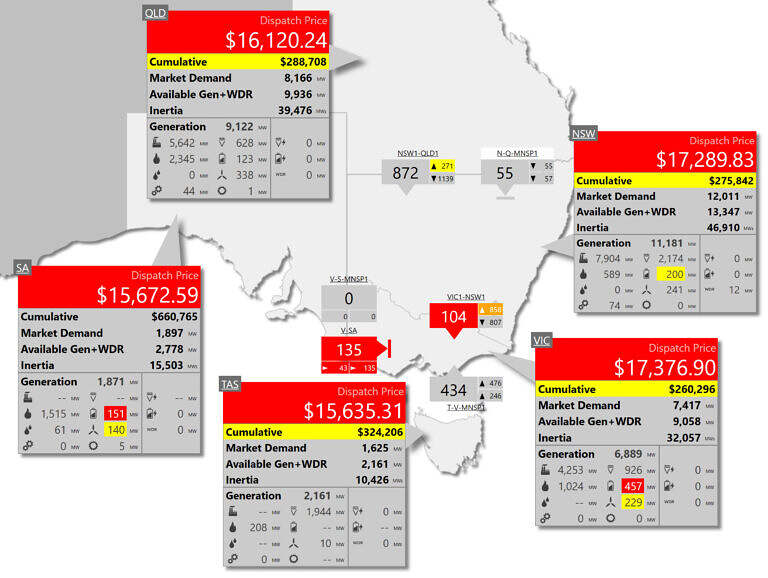 Record high electricity prices across the NEM. July 2024
Because we can’t get rid of coal fast enough, right? Somehow it’s a “harbinger of the price hikes” we’re facing “if aging fossil fuel generators are forced to stay open longer”. So geniuses, if prices hit $17,000 a megawatt-hour when some coal power is down for a day, what happens when we get rid of coal entirely? Is that when Tinkerbell saves the day by turning Sydney Harbor into a giant battery, or when $17,000 prices become the “new norm”?
Somehow the unplanned outages of reliable coal plants create sky high prices, whereas the unplanned outages of wind and solar power create Utopia.
Not so coincidentally, the price spikes on July 31 2024 occurred when wind and solar generators were out:
The price spikes were also boosted by the cold weather we aren’t supposed to be getting in our warmer world.
The synoptic chart for July 31 shows that old familiar pattern. One high pressure cell can ruin wind turbine production everywhere:
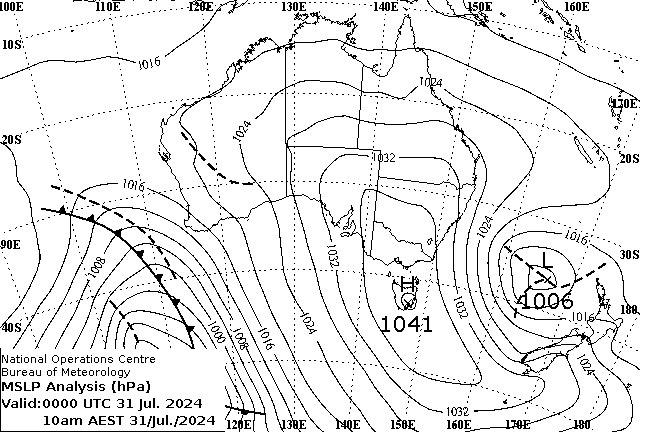 … Caitlin Fitzsimmons of the Sydney Morning Herald blames the slow-down in new wind farm approvals for the dire situation. But another 1,000 wind turbines won’t save the day when there is no wind. More useless wind power is still useless, it just costs more.
Blame the capitalists!
Poor Giles Parkinson at Reneweconomy blames the price spikes on evil profiteering but worries the public will think it’s renewable generators fault. He can see that these prices are bad news for the image of the “transition”:
What we see here is naked greed, around an essential service…
Geoff Eldridge, from GPE NEMLog, says the average wholesale price across all NEM regions hit a jaw-dropping $16,419/MWh in the early evening on Tuesday. That smashes the previous record of $12,491 /MWh reached on July 14, 2022, at the height of the international fossil fuel crisis sparked by the invasion of Ukraine.
With a perfectly straight face he complains about competition being reduced as reliable generators are forced out of the market:
Renewables are supposed to challenge this and lower the price on wholesale markets by introducing competition. But as the number of fully dispatchable generators declines, competition at critical times has actually been reduced – at least for the time – and like seagulls around a box of chips, the market players dive in.
This, of course, is exactly what the “renewable transition” was subsidized to do — to force out the cheaper competition. So the more we transition the more expensive it will get:
And the problem is that in a hotly partisan energy debate, and a lop-sided and populist media disinterested in actual facts, it will be renewables that get the blame.
But he seems to realize it isn’t a free market, and in that he is correct. The regulators allowed giant conglomerate groups to own competing generation units, which means they can play these off one another. When they drive out coal power they win big in the rest of their portfolio.
Battery storage is supposed to throw a bit more competition into the market. But the problem is that many of these assets are now owned or contracted to the very same energy giants that control the rest of the generation. If anything, it’s made it easier for them to control prices and profits.
Predatory capitalism worked well for AGL. They were given Liddell coal plant for nothing in 2014, but wouldn’t sell it for $250 million in 2018. It was worth more dead than alive. Banker analysts explained that they wouldn’t sell AGL either, because if someone else kept Liddell running it would keep wholesale electricity prices down (which is bad for all the other generators). Liddell coal power was shut down in April last year. If it was still running, we might not have had these price spikes. Where was Giles Parkinson when Liddell was being given away, run into the ground, and then driven out of the market? He was cheering the rigged market on. Now it is coming back to bite him.
The last few days were some of the lowest wind power for the month. There was high demand, but it was not a record:
 …. Paul McArdle at WattClarity drills through a few bidding details and says it appears there were more cheap bids than usual and the cold weather demand was a primary driver. But we will have to wait for the longer analysis that always occurs after these market disruptions.
Daily prices are on fire this week — the average wholesale prices for the last three days were about $250/MWh in NSW and Queensland, in the order of $300 in Victoria and Tasmania, and a shocking $675 for South Australia (which has lots of wind and solar power and no “old coal plants” at all). That’s effectively 72 hours of wildly high prices. And even though the retail electricity providers will be hedged, the spot prices still feed through to the retail electricity bills sooner or later.
9.8 out of 10 based on 109 ratings
8.5 out of 10 based on 20 ratings

By Jo Nova
And the flavor of the month is “failure”
Air New Zealand announced this week that it would not be able to cut its carbon emissions by 29% by 2030. The levers were “outside their control”, they lamented, which was the polite way of saying there isn’t enough sustainable jet fuel in the world, electric planes die after a few weeks, and no one has invented a low emissions plane yet. At the moment the only kind of Net-Zero-flying is not to fly at all.
Current supplies of sacred sustainable fuel are rapidly growing but barely 0.5% of total requirements. Even though production is expected to triple this year to 1.5 Mt of Sustainable Aviation Fuel, the industry needs 200 times what is currently available.
If someone could just invent an anti-gravity machine, or a nuclear jet…
By Charlotte Graham-McLay, Associated Press
Air New Zealand has pulled the plug on its climate targets saying the resources needed to meet them are unaffordable and unavailable.
In a statement the airline said it was removing its 2030 carbon intensity reduction target and will withdraw from the Science Based Targets initiative.
This is the sound of the free market saying “It’s a stupid idea”:
Sustainable transport researcher Dr Paul Callister said Air New Zealand’s climate target was unrealistic and was never going to be achieved. … “We’ve seen report after report saying that sustainable aviation fuels are not being produced and the quantities they should be and part of the problem is that airlines are not willing to pay the full cost of it. They’re wanting cheap fuels and they’re wanting government subsidies to pay for those fuels. It’s a bit of a vicious cycle.
Of course, if customers thought the world was really going to end they might be willing to pay for expensive fuels to prevent that. But no one really believes it.
It was all so different just a few years ago — endorsed by the most Experty experts:
Tuesday’s update was a sharp turnaround from a 2022 announcement by Air New Zealand in which it declared itself the second carrier in the world to have its plans validated by the U.N.’s Science Based Targets initiative aviation framework. It pledged a 28.9% reduction in carbon emissions by 2030, from a 2019 baseline, with a 16.3% drop in absolute emissions.
It was a Science Based Target don’tcha’know?
Meanwhile in Australia most companies are far behind Air New Zealand. Where the airline has tried and failed, 42% of Australian companies have not even started.
By Jared Lynch, The Australian Business Review
Now, a survey of more than 500 companies from Schneider Electric — the biggest adviser of Australian commercial power users — says 28 per cent have no intention of meeting their Paris Agreement commitments. A further 42 per cent say they have not begun decarbonising their operations.
The worst performers in meeting climate goals were smaller companies, healthcare, construction and professional services, with the Schneider survey revealing 18 per cent did not know where to start, while almost a quarter did not consider it a priority.
Ponder just how devastating this is. 42% of Australian companies have not even begun, and another 28% have no intention of finishing.
That’s a 70% failure rate.
Image by Eynoxart from Pixabay
9.8 out of 10 based on 110 ratings
9.1 out of 10 based on 11 ratings
By Jo Nova
There is hope: Despite the censorship, and the partisan bias in the media, more than half the country has shaken off the propaganda.
All our institutions and experts have been telling us “renewables are cheaper” for twenty years, yet two out of three people don’t believe them. In a similar vein 58% of people could believe electric cars were just as bad for the environment as petrol cars. 50% believe renewable energy leads to blackouts, causes harm to whales and takes away our best farmland. And half the country agrees there is no consensus among the experts either.
We haven’t had a strong election battle on the renewables transition, but statistics like these suggest that if the Opposition picked up on this fear, they would be pushing on an open door.
The IPSOS survey (n=1,000)
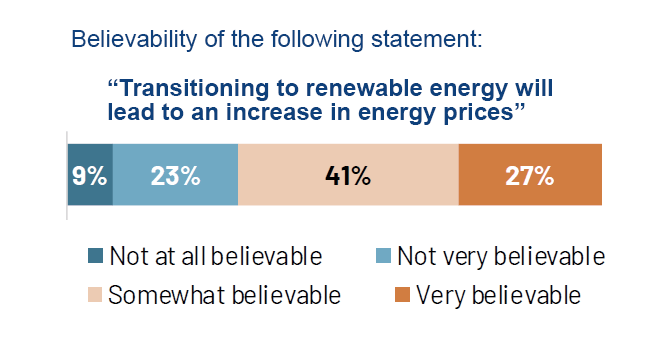
And despite higher prices being exactly what happens in every country on Earth, IPSOS arrogantly labels this belief as “Misinformation”.
(Click to enlarge).
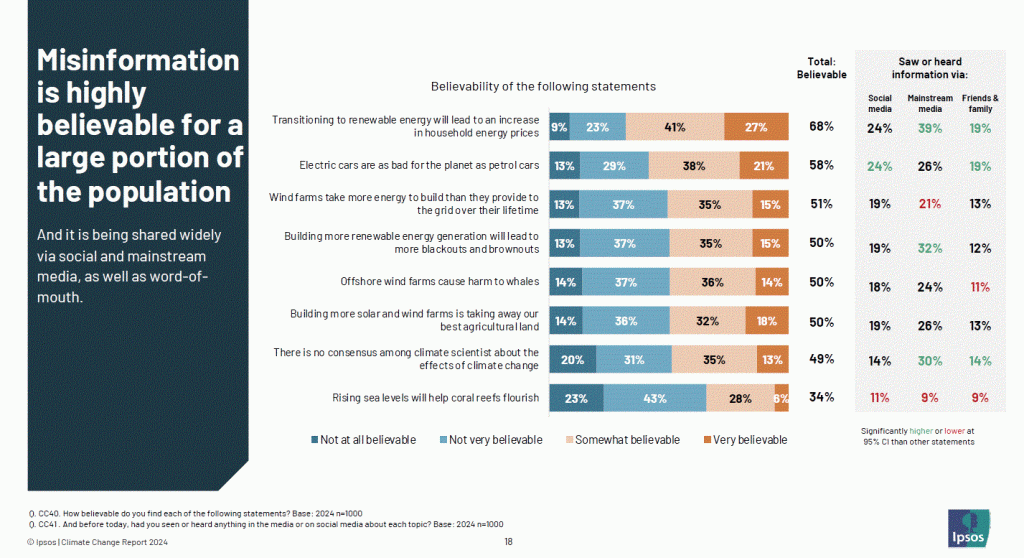
They also asked people whether they had “seen or heard anything in the social media about this?” But only 39% said they had seen something on this in the mainstream media. So most of the population hadn’t even seen this discussed on TV or radio yet. Imagine how many more people would know that the transition would ramp up electricity prices if the TV news actually interviewed skeptical engineers, NASA astronauts or Nobel prize winners like John Clauser, every now and again.
We are a country divided and cynical. Half the nation don’t believe the CSIRO or the ABC even a bit. Only 40% think it will be good for the economy. Only 32% think it will increase jobs in their area.
Support for the renewables transition is falling away
In the last 2 years, a tenth of those who thought Australia should be “a world leader” in the energy transition have left the ranch.
And the most important thing to the people was not a speedy transition, but cheap electricity and reliable power.
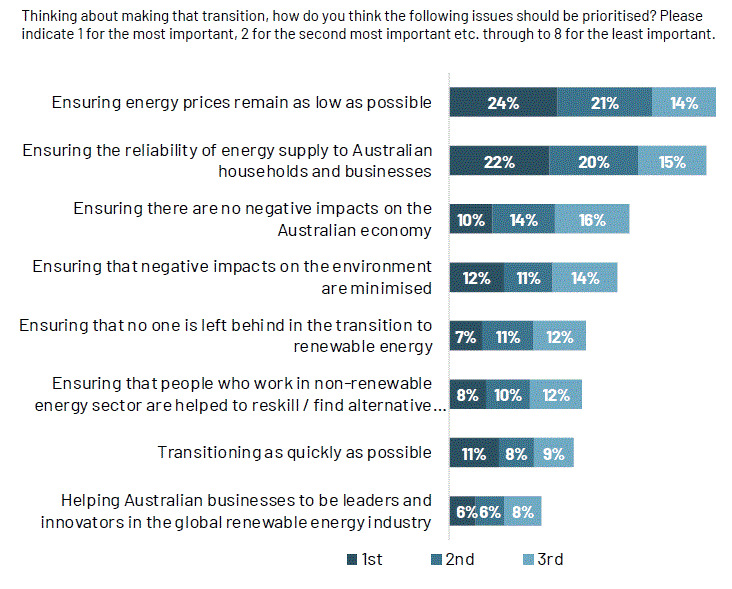
Only 28% think we will meet our Net Zero targets
Boy are they in for a shock…
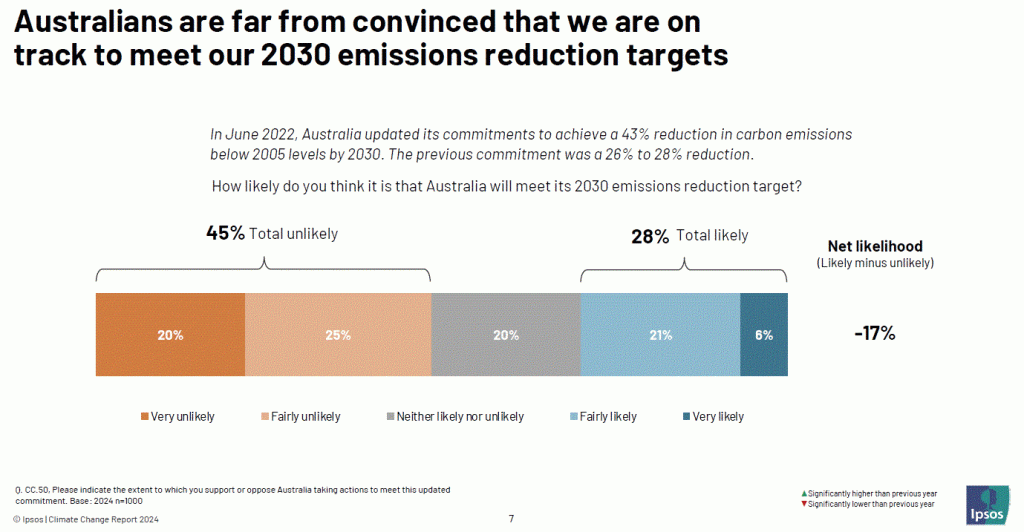 https://www.ipsos.com/en-au/australians-now-more-concerned-about-green-energys-impact-cost-living-and-electricity-bills
Half the nation still thinks (paradoxically) that switching to solar and wind power will improve air quality. Thirty years of teachers, news-readers and politicians calling carbon dioxide “pollution” sowed this confusion.
See the Epoch Times for more commentary on the survey.
See the crowd at Reneweconomy tie themselves in knots with excuses.
But it’s not difficult to see why more Australians are now associating wind and solar farms with higher power bills and cost of living more generally, says the Grattan Institute’s Allison Reeve.
“It’s only very recently that we’ve come to this point where renewables have become the cheapest form of energy, so people who don’t think about energy all the time for a living will have a shortcut in their brain and say ‘oh renewables are more expensive’,” she says.
They’re trying to pretend that the idea of “cheap renewables” is a whole new thing that the masses haven’t been trained-to-death with for two decades.
9.9 out of 10 based on 85 ratings
10 out of 10 based on 11 ratings
 … By Jo Nova
It’s hard to keep up with the great EV unravelling
The best news for the EV industry this month is that Ford is only losing $50,000 a car now on its electric vehicles. That’s so much better than the $132,000 it was losing last quarter. But the true economic carnage is deep and widespread. The one sure bet in the world of electric vehicles was Tesla where sales rose two percent in the last quarter but their profits plummeted 45%. The fire-sale shifted cars but it burned the bottom line. Similarly Mercedes Benz profits were down 21%, mostly thanks to EVs. And Ford’s were down 35% (not surprisingly).
We knew things were bad when the new invention has a small market share but already half of the owners wanted to go back to the old style.
There is trouble even in China where shares in Evergrande New Energy Vehicle are down almost 40% so far this year. Apparently some creditors are coming after Evergrande seeking bankruptcy proceedings for two of its EV arms.
Nearly every major manufacturer is delaying new models or rewriting their targets. Ford is delaying several models, and is redesigning a plant in Canada that was going to make EVs to one that will build pick-up trucks with fossil fuel engines. Bentley and Aston Martin have pushed back the launch of their first EVs. Jaguar have said they will drop two of their planned EV models and keep making their gasoline SUV for longer. Volkswagen diverted $60 billion back into developing ICE cars. Suddenly, they’ve all discovered that Hybrid cars are quite interesting.
Porsche kept their target and dumped it at the same time. They are still (theoretically) aiming to get 80% of its vehicle sales to be electric by 2030. But they added the clause “if the customers support us”. Anything less than 80% will be the customers fault. Porsche off the hook, eh…
Someone is going to write a book about how the top industrial heavyweights of the West virtually all fell for the fantasy that we could toss out a century of engineering and ding, invent new type of car on command. Discovery in aisle nine!
The EV bubble deflates in real time
By Matthew Lynn, The Telegraph
Over the last few days, it has become clear that the EV industry is on the brink of collapse. Hundreds of billions of euros, dollars and pounds have been pumped into this industry by political leaders and the subsidy junkies that surround them – and it is surely time they were held to account for the vast quantities of taxpayer cash that has been wasted.
And it’s not just car makers. It’s bad news for the supply line:
It is even worse for component manufacturers. Shares in Germany’s Varta are down by 70pc over the last month amid reports that the company may have to be rescued from bankruptcy after making heavy losses on batteries for hybrid sports cars. This week, the Belgium chemicals group Umicore announced a €1.6bn (£1.4bn) hit, as manufacturers warned of waning EV demand, and it postponed plans for a battery recycling plant.
As Matthew Lynn says: consumers are increasingly nervous over what may become obsolete technology. That’s got to be the marketing kiss-of-death.
Western governments threw billions of dollars to inflate this bubble
Politicians tried to play God in the car market: In France Macron tossed €700m at a plan to dominate battery production in partnership with Germany. The Germans burned €1bn too. But the EU bragged that it spent €80bn on things to do with EVs, and the US had launched cargo-ships of cash with the Inflation Reduction Act.
In the end, in the biggest transition of them all, from horse to car, Ford didn’t need a government subsidy to invent a Model T. And customers didn’t need to be forced to buy it either.
10 out of 10 based on 134 ratings
7.5 out of 10 based on 14 ratings
9.3 out of 10 based on 19 ratings
By Jo Nova
Like a sabre:
“I am the ultimate diversity hire, I’m both a woman and a person of color, so if you criticize anything I say, you’re both a sexist and a racist”
AI will destroy jobs… (hopefully one in particular).
But both sides can use this tool — to construct a narrative, as well as to destroy it.
Reality may become very hard to find with unmarked Deepfake voices “on the loose” — especially if there is no shared public forum to hammer out the truth. That seems like a brilliant but dangerous game. The thing about great satire, as opposed to deepfake lies, is that when it’s done well, and it speaks the truth (in a fake voice), the target wouldn’t want to draw attention to it by denying they said it.
But perhaps we need an AI watermark…
h/t Stephen Neil
9.9 out of 10 based on 100 ratings
9.4 out of 10 based on 12 ratings
8.3 out of 10 based on 17 ratings

By Jo Nova
The government has this hope that homeowners can be tricked into paying for the batteries (in the form of EVs) that the wind and solar industry need to make their useless random energy into something reliable. Now comes the news that not only are batteries hazardous fire risks and expensive themselves, but to connect to our grid in a two way arrangement we need to spend $3,000 dollars per household (or maybe $10,000) to buy the bit of equipment that makes this work. Not to mention adding another million gigawatts of generation so the cars can be charged in the first place.
Remember in the end, we are not buying EV’s because they go further, cost less, or are more convenient, we’re buying them because we want to stop storms in 100 years.
How many nice weather days will I get in 2100AD for that $3,000 inverter?
By Natasha Schmidt, The Australian
Interim Director of Monash Energy Institute, Roger Dargaville, said powering EVs in just one million households could cost as much as $10bn in power inverters.
Professor Dargaville said such inverters, unlike home batteries such as Tesla’s Powerwall, would allow EV drivers to recontribute power into the grid.
“That piece of infrastructure costs about $10,000 at the moment, and if you have a million vehicles sometime in the future trying to do this that’s $10bn,” he said.
Prof Dargaville hopes that mass production might reduce the cost to $3,000 each if we are lucky. (Mass money printing and inflation will probably prevent that.)
Historians will look back on this era and describe it as a case study in corruption and mass delusion. The great capitalist free market of Adam Smith exists only in limited pockets that masquerade as “free choice”.
10 out of 10 based on 93 ratings
8.4 out of 10 based on 29 ratings
By Jo Nova
If Australia gets any more free cheap energy we’ll go broke
The Australian Energy Regulator has the data on electricity pricing and possibly a budget $20 million a year but hasn’t yet updated with the last quarter, so I thought I’d help them out. Because surely this is a graph that all Australians need to see?
This is every state in the National Energy Market, and even though some have more renewables than others, the long term trends are the same. Unreliable generators in one state can vandalize the whole market:
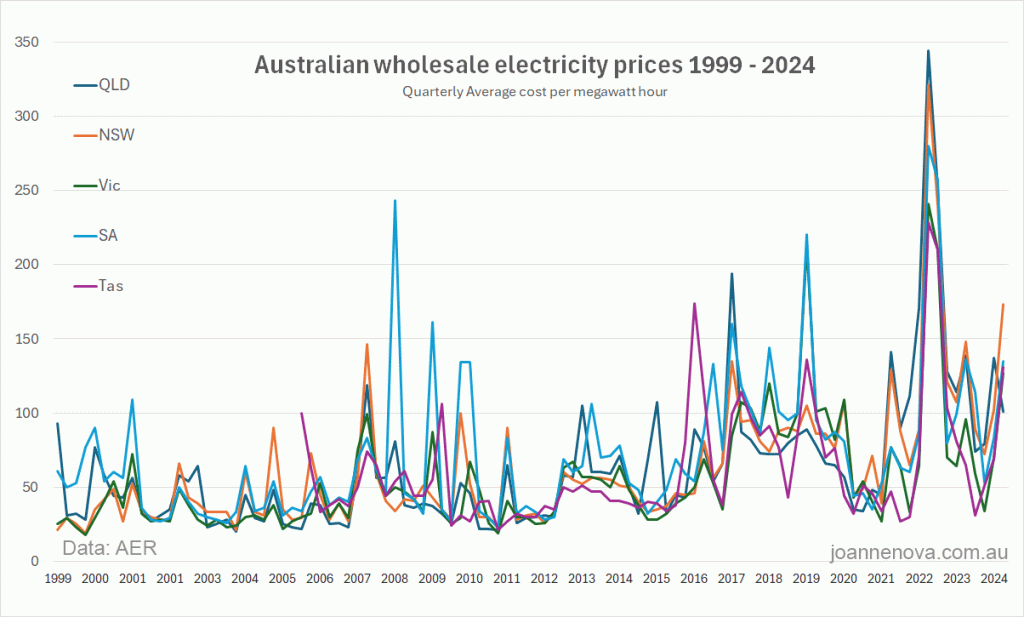 (Click to expand). Back in the dinosaur days when Australia had virtually no wind and solar power, the price for wholesale electricity was $30 a megawatt hour year after year. Then Kevin Rudd was elected in 2007, and we started to add the intermittent, unreliable generators which have free fuel, but need thousands of kilometers of wires, batteries, subsidies, schemes, farmland, FCAS markets, and an entire duplicated back up grid that sits around not-earning money for hours, days or five years at a time.
And we wondered why electricity got more expensive:
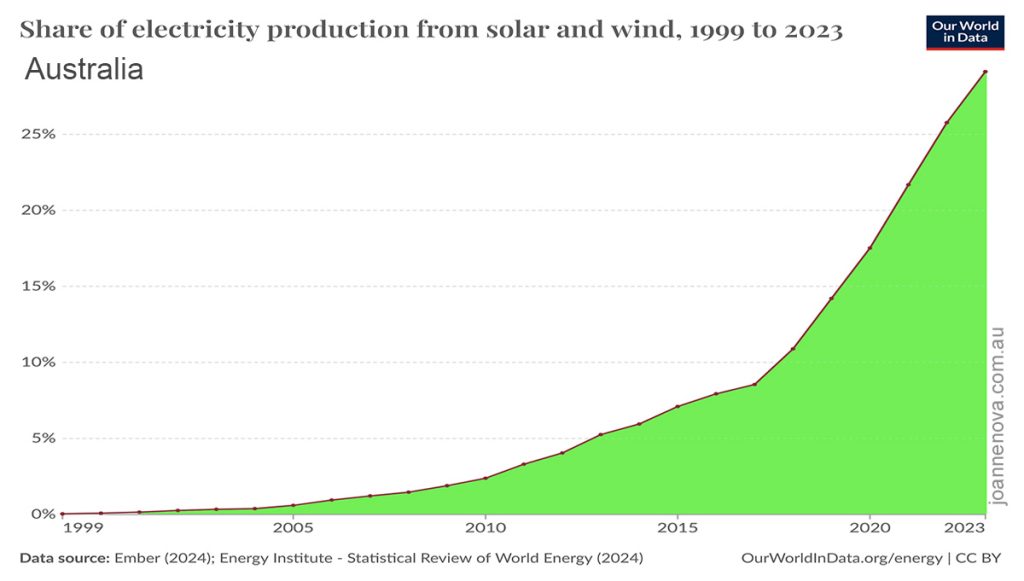
And again with labels.
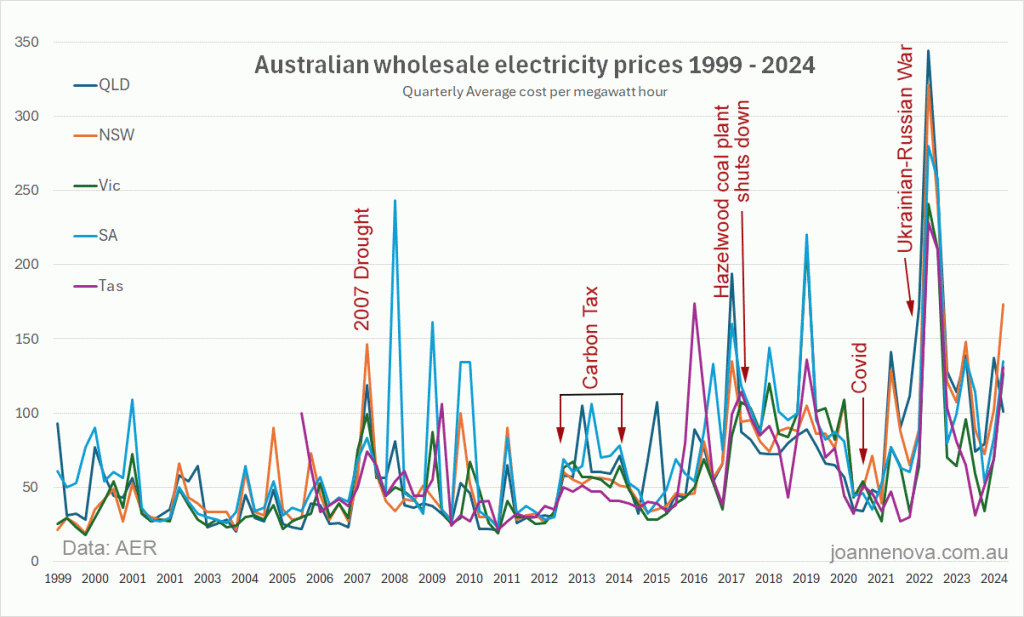
The market never did recover from the closure of the Hazelwood coal plant. Costs rose by 85% and it took a pandemic to bring them down again, but only temporarily.
So Australia is close to 30% total wind and solar generation, and aiming with gossamer fairy wings for 82% in five years time.
Luckily, it appears there’s no chance we’ll get there. The solar daytime glut, negative prices and community hatred of high voltage lines is spoiling the market for developers. And not a day too soon….
REFERENCES
Keep reading →
9.8 out of 10 based on 101 ratings
8.5 out of 10 based on 15 ratings
By Jo Nova
It’s another outbreak of the Hottest-ever-Day Fever , where buses catch fire, and the worlds top journalists forget to ask anyone anything useful about the last 500 million years.
The Copernicus data might be fine and dandy but it only goes back as far as 1979. The warm weather we are having now is just a welcome break in a cooling trend that started 7,000 years ago. It not only isn’t a record that means anything, it’s almost certainly a net benefit to warm blooded mammals.
The collective amnesia about the Holocene and most of the history of human civilization is complete. Apparently the world is in uncharted territory, except for thousands of rocks, stones, spears, shells, bits of wood, pollen, diatoms, fossilized plant leaves, and all the ice cores we’ve ever dug up. 4,000 stone-age spears and whatnot that melted out of the Norwegian glaciers in the last few years, must have frozen into them sometime in the last 5,000 years. And all the bones of dogs, rabbits, geese and frogs found inside the Arctic circle suggest our world is too brutally cold now. Likewise the giant oyster shell found on a building site in Taiwan reminds us of a time the oceans were 1 to 2 meters higher than today, and the cavemen survived just fine.
CNN By Angela Fritz
Sunday was the hottest day in recorded history, according to preliminary data from a climate tracking agency monitoring temperatures since the mid-1900s.
It’s the second consecutive year average global temperatures have crashed through shocking climate records and will not be the last, as planet-warming fossil fuel pollution drives temperatures to shocking new highs.
July 21 clocked in at 17.09 degrees Celsius, or 62.76 Fahrenheit, and was the hottest day on Earth since at least 1940, according to the preliminary data from the European Union’s Copernicus Climate Change Service.
It’s 100,000 years of journalistic negligence:
Despite being based on data from the mid-20th century, the temperature records represent the warmest period the planet has seen in at least 100,000 years, scientists have found from many millennia of climate data extracted from ice cores and coral reefs.
Someone should send Angela Fritz (and most of the world’s journalists) the graphs of the ice cores which she has clearly never seen:
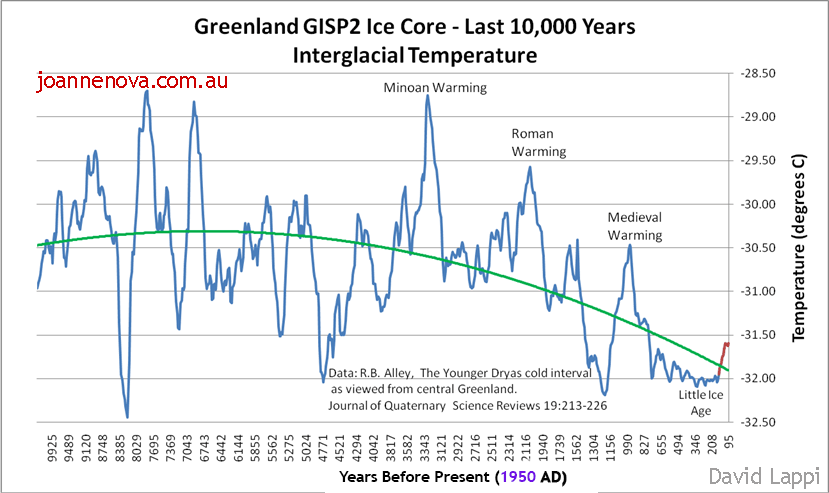 7,000 years of cooling in Greenland. This graph shows the ice-core data up until 1855. The last 150 years (1705 to 1855) are highlighted in red to show the warming as the Earth began coming out of the LIA. Send them the Vostok Ice Cores too. Send them Brazilian sea levels, and tell them the the Sahara was lush green and wet, and the water near Indonesia was 2 degrees hotter. And 6,000 boreholes drilled around the world agree, along with 700 Pacific Islands that aren’t shrinking. The real science deniers are the ones ignoring half a billion years of evidence.
It’s been hotter for thousands of years during human civilization and it wasn’t caused by our cars.
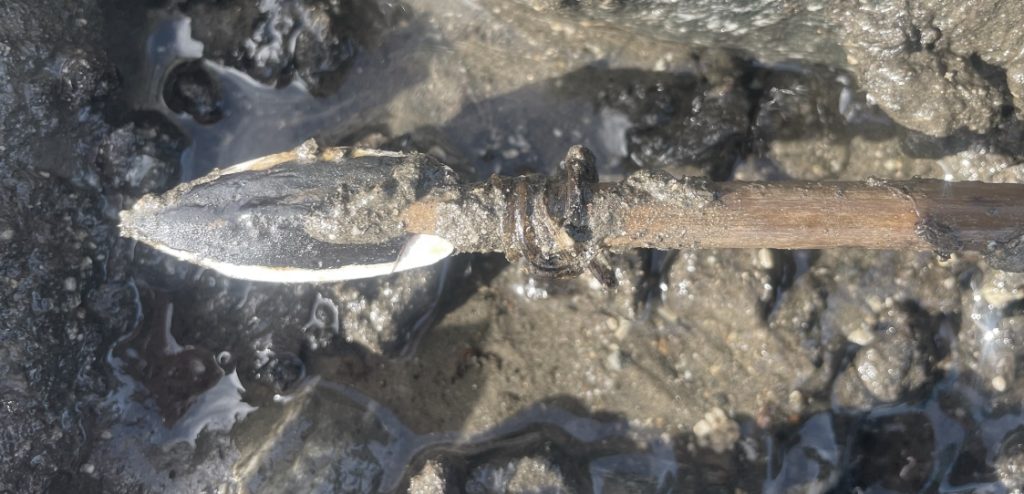 https://secretsoftheice.com/ REFERENCES
Copernicus media release –they it’s a the hottest day “in recent history” which the media turned into the hottest day in a hundred thousand years. h/t Gee Aye
Keep reading →
9.8 out of 10 based on 102 ratings
8.8 out of 10 based on 16 ratings
|
JoNova A science presenter, writer, speaker & former TV host; author of The Skeptic's Handbook (over 200,000 copies distributed & available in 15 languages).

Jo appreciates your support to help her keep doing what she does. This blog is funded by donations. Thanks!


 Follow Jo's Tweets
Follow Jo's Tweets To report "lost" comments or defamatory and offensive remarks, email the moderators at: support.jonova AT proton.me
Statistics
The nerds have the numbers on precious metals investments on the ASX
|



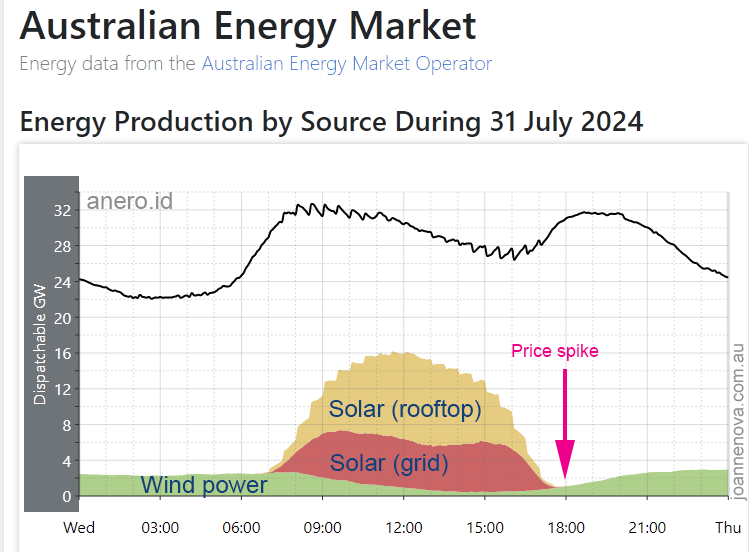












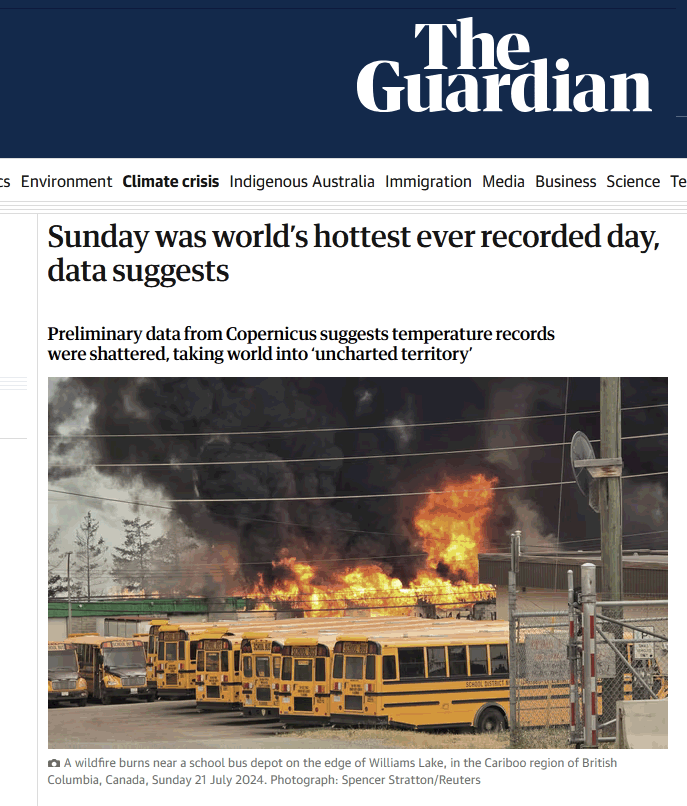













Recent Comments